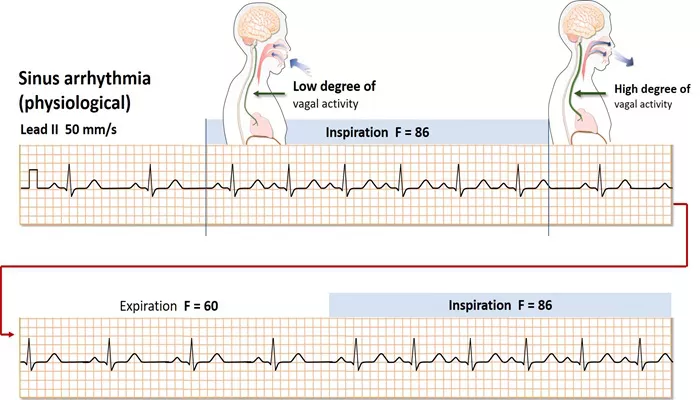Sinus arrhythmia is a common phenomenon observed in electrocardiograms (ECGs), particularly in young, healthy individuals. It is characterized by a variation in the heart rate that correlates with the respiratory cycle. This article delves into the details of sinus arrhythmia, its mechanisms, clinical significance, and how it is represented on an ECG.
What Is Sinus Arrhythmia?
Sinus arrhythmia refers to an irregularity in the heart rhythm originating from the sinoatrial (SA) node, which is the heart’s natural pacemaker.
This condition manifests as variations in the intervals between heartbeats, specifically the P-P intervals on an ECG. Sinus arrhythmia can be classified into two main types:
Respiratory Sinus Arrhythmia: This is a physiological phenomenon where the heart rate increases during inhalation and decreases during exhalation. It is generally considered benign and is most commonly seen in younger individuals.
Non-respiratory Sinus Arrhythmia: This type may occur independently of breathing and can be associated with underlying health issues, particularly in older adults.
Mechanism of Sinus Arrhythmia
The primary mechanism behind sinus arrhythmia involves changes in vagal tone during the respiratory cycle:
Inspiration: During inhalation, vagal tone decreases, leading to an increase in heart rate.
Expiration: Upon exhalation, vagal tone increases again, resulting in a decrease in heart rate.
This cyclical variation can result in P-P intervals that differ by more than 120 milliseconds (0.12 seconds) from one beat to the next13.
SEE ALSO: Can Arrhythmia Cause Heart Attack?
Clinical Significance
In healthy individuals, sinus arrhythmia is typically benign and does not require treatment. However, it can be a sign of underlying pathology when observed in older adults or when it occurs without respiratory correlation. Non-respiratory sinus arrhythmia may indicate conditions such as sick sinus syndrome or other cardiac abnormalities.
Characteristics of Sinus Arrhythmia on ECG
To effectively identify sinus arrhythmia on an ECG, several key features must be noted:
P-P Interval Variation:
The P-P interval varies significantly, often exceeding 120 milliseconds.
The variation is cyclical and corresponds to the phases of respiration.
P Wave Morphology:
The P waves appear normal and maintain a consistent morphology across the ECG leads.
There should be no evidence of premature atrial contractions or other abnormalities.
P-R Interval Consistency:
The P-R interval remains constant throughout the tracing, indicating no atrioventricular (AV) block.
Ventricular Rate:
The ventricular rate may be irregular but typically remains within normal limits (60-100 beats per minute).
ECG Examples:
In some cases, the ECG may show a significant variability between the longest and shortest P-P intervals, demonstrating a range of heart rates from approximately 57 bpm to 100 bpm.
Differential Diagnosis
When assessing for sinus arrhythmia, it is crucial to differentiate it from other conditions that may present similarly:
Premature Atrial Contractions (PACs): These can cause irregularities but usually have distinct P wave characteristics.
Second-degree AV Block (Mobitz I): This presents with progressively longer P-R intervals before a dropped beat.
Sinoatrial Exit Block: Characterized by missed beats due to failure of impulse transmission from the SA node.
Recognizing these differences helps ensure accurate diagnosis and appropriate management.
Symptoms Associated with Sinus Arrhythmia
While many individuals with sinus arrhythmia experience no symptoms, some may report sensations such as:
- Palpitations
- Fatigue
- Shortness of breath
- Dizziness or lightheadedness
In cases where sinus arrhythmia leads to significant changes in heart rate—either too fast (tachycardia) or too slow (bradycardia)—there may be additional risks such as reduced cerebral perfusion leading to syncope or transient ischemic attacks.
Diagnosis of Sinus Arrhythmia
Diagnosing sinus arrhythmia typically involves:
Electrocardiogram (ECG): The primary tool for identifying sinus arrhythmia through its characteristic patterns.
Holter Monitoring: For patients whose symptoms are intermittent or not captured during a standard ECG, continuous monitoring over 24-48 hours can provide clarity.
Echocardiography: This imaging technique may be used to assess cardiac structure and function if underlying pathology is suspected.
Treatment Options
In most cases, no specific treatment for sinus arrhythmia is necessary, especially if it is physiological and asymptomatic.
However, management strategies may include:
Observation: Regular monitoring for changes in symptoms or rhythm.
Lifestyle Modifications: Encouraging patients to adopt heart-healthy habits such as regular exercise, stress management techniques, and dietary adjustments.
Medical Intervention: In cases where non-respiratory sinus arrhythmias are linked to other cardiac conditions or symptoms are significant, medications or further interventions may be warranted.
Conclusion
Sinus arrhythmia represents a fascinating aspect of cardiac physiology that highlights the intricate relationship between respiratory function and heart rhythm. While typically benign in younger populations, its presence in older individuals warrants careful evaluation to rule out underlying pathology. Understanding its characteristics on an ECG not only aids clinicians in making accurate diagnoses but also ensures that patients receive appropriate care tailored to their specific needs.
Related topics:
- Can Not Eating Enough Cause Heart Arrhythmia?
- Will Atrial Fibrillation Shorten My Life
- What Are The Possible Complications of Untreated Sinus Arrhythmia

